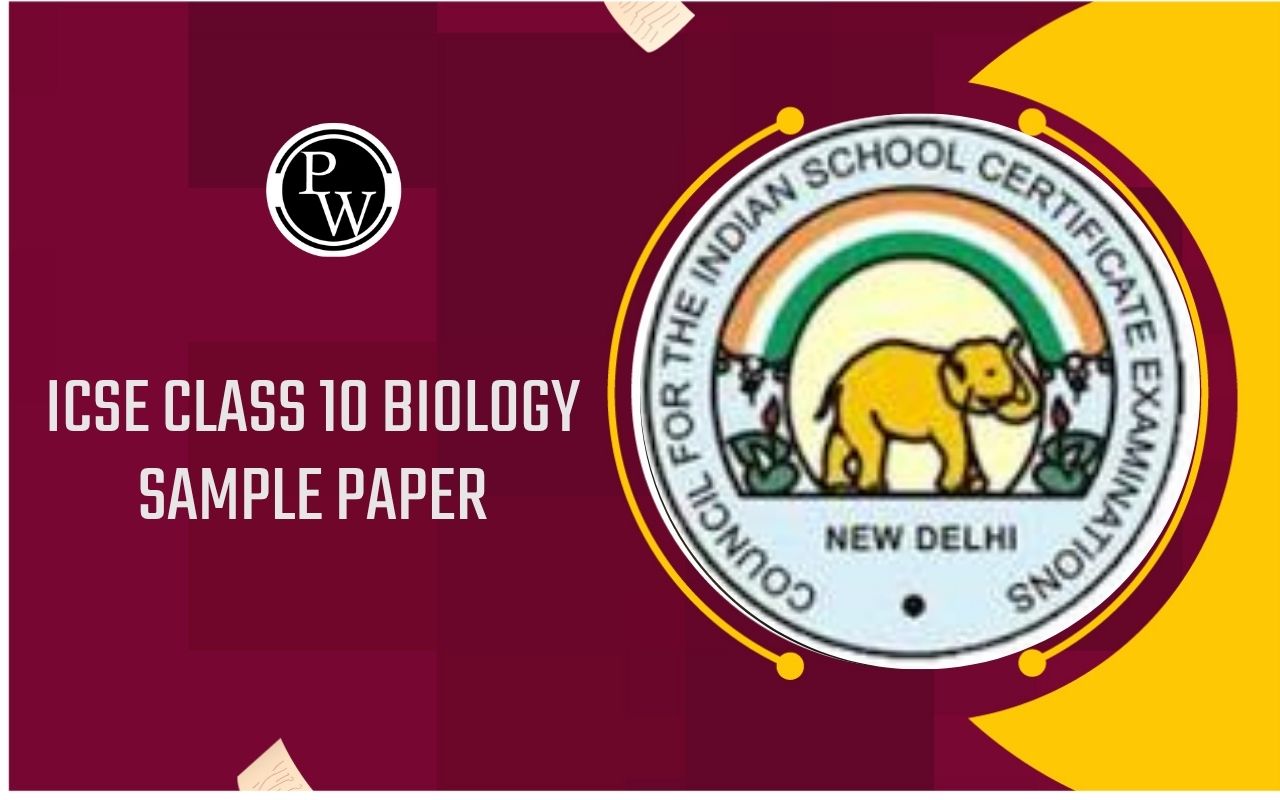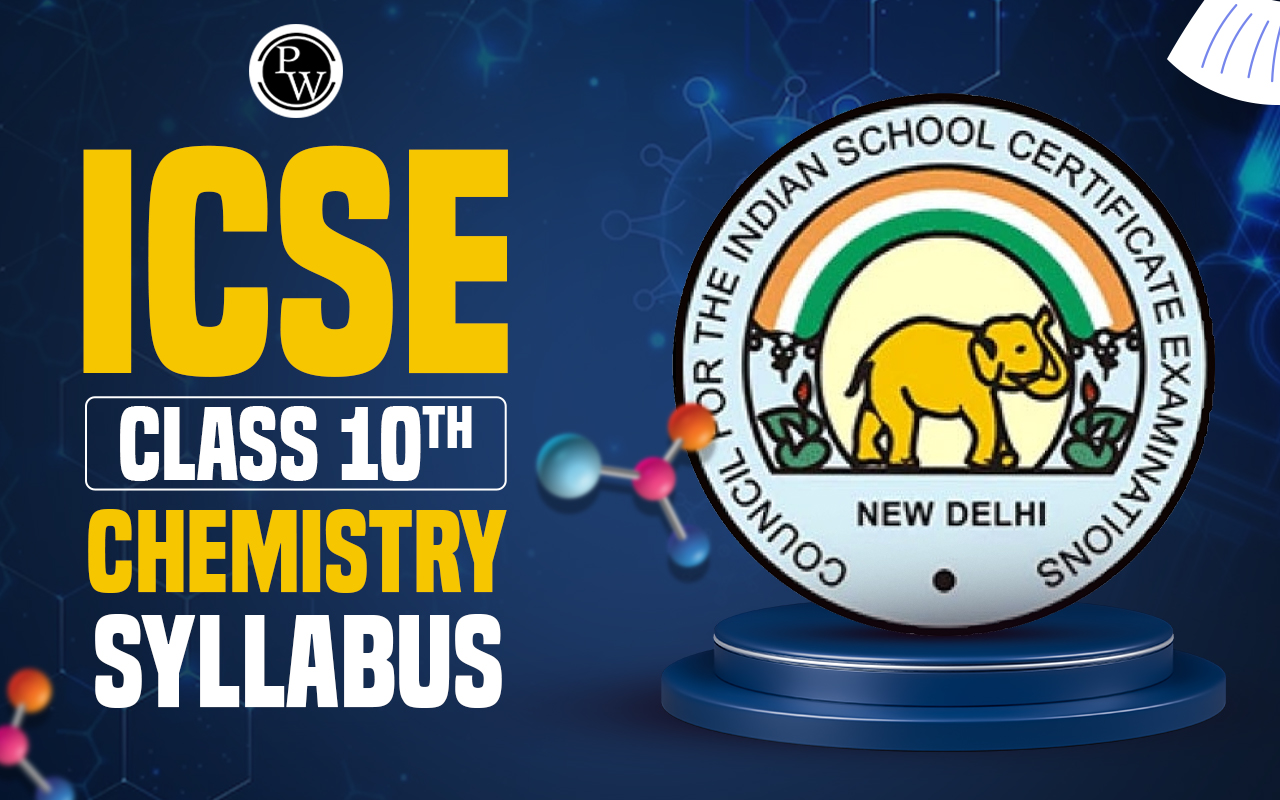
ICSE Class 10 Biology syllabus for the academic year 2025 has been officially released by the Council for the Indian School Certificate Examinations (CISCE).
This syllabus outlines the key topics and concepts that students are expected to study, providing a structured framework for their learning journey.
It encompasses various areas such as cell biology, genetics, plant and human physiology, evolution, and environmental science.
By thoroughly reviewing the syllabus, students can gain a clear understanding of the subjects to be covered, enabling them to plan their studies effectively and approach the upcoming board exams with confidence.
ICSE Class 10 Biology Selena Solutions
ICSE Board Class 10 Biology Syllabus 2025 Overview
ICSE Class 10 Biology syllabus is designed to build a strong foundation in the fundamental concepts of biology, preparing students for higher studies in science and related fields.
It covers various important topics ranging from human physiology to ecology and genetics. Students must have a clear understanding of the syllabus to plan their studies effectively.
|
ICSE Board Class 10 Biology Syllabus 2025 Overview |
|
|
Board |
Council for the Indian School Certificate Examinations (CISCE) |
|
Class |
10th |
|
Academic Year |
2025 |
|
Subject |
Biology |
|
Exam Duration |
3 hours |
|
Official Website |
|
ICSE Class 10 Biology Syllabus 2025 Exam Pattern
Biology is a branch of science that focuses on studying the physical and chemical aspects of life, covering topics such as the origin, structure, functions, evolution, distribution, identification, and classification of living organisms. Students preparing for the ICSE Class 10 board Exams in 2025 should be acquainted with the ICSE Class 10 Biology Syllabus 2025 and the Question Paper Design. Review the essential details of the ICSE Class 10 Biology Question Paper.
- The examination will consist of one two-hour paper carrying 80 marks, along with Internal Assessment of practical work contributing 20 marks.
- The paper will be divided into two parts, Section I (40 marks) and Section II (40 marks).
- Section I is mandatory and will feature short answer questions covering the entire syllabus.
- Section II will have six questions, and candidates must answer any four out of these six questions.
Check the table below for more details:
| ICSE Class 10 Biology Syllabus Exam Pattern | |||
| Section | Marks | Number of Questions | Type of Questions |
| I | 40 | Multiple (All questions are mandatory) | Short answer questions covering the complete syllabus |
| II. | 40 | 6 questions (Answer any 4 out of 6) | Long answer questions |
ICSE Class 10 Biology Syllabus 2025-26 Chapter-Wise
The ICSE Class 10 Biology Syllabus for comprises six chapters, covering areas such as Plant Physiology, Human Anatomy and Physiology, Population, Human Evolution, and more. To perform well in their final exams, students need to focus on the entire syllabus since the ICSE (Class X) Examination paper will be based solely on the Class X section.
To score high marks in the Class 10 Biology exam, candidates should thoroughly study and revise all the topics outlined in the ICSE Class 10 Biology Syllabus for 2025. The syllabus includes the following topics and subjects:
Chapter 1: Basic Biology
(i) Cell Cycle and Cell Division: The cell cycle includes Interphase (G1, S, G2) and the Mitotic phase. Regarding Cell Division:
- Understand Mitosis and its stages.
- Have a basic grasp of Meiosis as a reduction division (details not necessary).
- Get a brief idea about homologous chromosomes, crossing over, and their role in variations.
- Know the significance and major differences between mitotic and meiotic division.
(ii) Structure of Chromosome: Understand the basic structure of a chromosome, including terms like chromatin, chromatid, gene structure of DNA, and centromere.
(iii) Genetics: Focus on Mendel’s laws of inheritance and sex-linked inheritance of diseases:
- Know Mendel’s three laws.
- Understand Monohybrid cross for phenotype and genotype.
- For Dihybrid cross, cover only phenotype.
- Key terms to cover: gene, allele, heterozygous, homozygous, dominant, recessive, mutation, variation, phenotype, genotype.
- Understand sex determination in humans and sex-linked inheritance, including X-linked diseases like haemophilia and colour blindness.
Chapter 2: Plant Physiology
(i) Absorption by Roots and Transport:
- Understand processes related to water absorption by roots.
- Know characteristics of roots suitable for water absorption.
- Understand the structure of a single full-grown root hair.
- Get a general idea of Cohesive, Adhesive forces, and transpirational pull.
- Cover experiments demonstrating water conduction through the xylem.
(ii) Transpiration:
- Understand the concept and importance of transpiration in plants.
- Cover experiments on transpiration, such as weight loss in a potted plant or leafy shoot.
- Include the mechanism of stomatal transpiration based on the potassium ion exchange theory.
- Discuss adaptations in plants to reduce transpiration.
- Provide a brief idea of guttation and bleeding.
(iii) Photosynthesis:
- Understand the process and its importance.
- Cover experiments showing the necessity of light, carbon dioxide, chlorophyll, starch formation, and oxygen release.
- Briefly explain the internal structure of the chloroplast.
- Discuss stomatal opening and closing based on the potassium ion exchange theory.
- Provide an overall balanced chemical equation for photosynthesis.
- Introduce terms like "photochemical" and "biosynthetic" for light and dark phases.
- Cover light and dark reactions with key points, and adaptations in plants for photosynthesis.
- Discuss experiments on factors essential for photosynthesis, emphasising destarching and steps in the starch test.
- Include a diagrammatic representation of the carbon cycle.
(iv) Chemical Coordination in Plants:
- Have a general understanding of plant growth regulators.
- Briefly cover the physiological effects of Auxins, Gibberellins, Cytokinins, Abscisic acid, and Ethylene on plant growth.
- Understand tropic movements in plants, including Phototropism, Geotropism, Hydrotropism, Thigmotropism, and Chemotropism, with suitable examples.
Chapter 3: Human Anatomy and Physiology
(i) Circulatory System:
This section covers the Blood and Lymph, explaining the heart's structure and function, blood vessels, and blood circulation. Only the main blood vessels entering and leaving the heart, liver, and kidney are mentioned. The lymphatic system is also discussed. Information includes the composition of blood, details about red blood cells (RBC), white blood cells (WBC), and platelets. The concept of tissue fluid and lymph is briefly explained, along with why mammalian red blood cells are more efficient due to the absence of certain organelles. Blood coagulation and the concept of systole and diastole, as well as double circulation, are covered. Pulse and blood pressure are briefly introduced, and the different blood vessels—artery, vein, and capillary—are explained with diagrams. The lymphatic organs, spleen and tonsils are mentioned, and the ABO blood group system and Rh factor are discussed. The hepatic portal system's significance is also touched upon.
(ii) Excretory System:
This section provides a brief introduction to excretory organs, parts of the urinary system, and the structure and function of kidneys. The associated blood vessels and the structure and function of nephrons are covered. The external and internal structure of the kidney is explained, along with the urinary system's various parts and their functions, emphasising diagrams with correct labelling. A general idea of the structure of a kidney tubule/nephron is provided. Ultra-filtration, selective reabsorption, and tubular secretion in relation to blood plasma and urine composition are briefly explained, with emphasis on the malpighian capsule diagram.
(iii) Nervous System:
This section discusses the structure of neurons, the central, autonomous, and peripheral nervous systems, the brain and spinal cord, and reflex action versus voluntary action. Sense organs, such as the eye and ear, are covered, detailing their structure, functions, defects, and corrective measures. The external structure of the brain and its primary parts are mentioned, along with the distribution of white and grey matter in the brain and spinal cord. Voluntary and involuntary actions, reflex arc explanation with a pathway from receptor to effector, and a brief idea of the peripheral and autonomic nervous system are provided. Differences between natural and acquired reflex are discussed, as are the external and internal structure and functions of the eye and ear. Stereoscopic vision, adaptation, and accommodation of the eye, along with eye defects and corrective measures, are briefly covered. The course of sound perception in the human ear and the ear's role in maintaining body balance are also discussed.
(iv) Endocrine System:
This section presents a general study of glands such as the adrenal, pancreas, thyroid, and pituitary, distinguishing between endocrine and exocrine glands. The exact location and shape of endocrine glands in the human body are discussed, along with hormones secreted by each gland. The effects of hypo and hyper secretion of hormones are covered, and a brief idea of feedback mechanisms with reference to TSH is provided.
(v) Reproductive System:
This section covers organs, fertilisation, the functions of the placenta in embryo growth, and the menstrual cycle. Functions of male and female reproductive organs, male accessory glands, and secondary sexual characters are discussed. The structure and functions of sperm and egg parts are explained, along with terms like fertilisation, implantation, placenta, gestation, and parturition. The role of the placenta in embryo nutrition, respiration, and excretion, along with its endocrine function, is briefly introduced. The functions of foetal membranes and amniotic fluid are outlined, along with an overview of the menstrual cycle. The role of sex hormones (testosterone, oestrogen, and progesterone) in reproduction is explained, and the concept of identical and fraternal twins is discussed, highlighting their meaning and differences.
Chapter 4: Population
- Addressing the Population Surge in India and the Urgency for Control Measures.
- Identification of Key Reasons for the Significant Increase in Human Population Locally and Globally.
- Simplified Definitions of Demography, Population Density, Birth Rate, Death Rate, and Population Growth Rate.
- Examination of Challenges Stemming from Population Growth: Unemployment, Natural Resource Exploitation, Low Per Capita Income, Inflation, Pollution, and Wealth Inequality.
- Overview of Population Control Methods, Including Surgical Approaches Such as Tubectomy and Vasectomy.
Chapter 5: Human Evolution
- Basic Introduction to Human Evolution.
- Exploration of Evolution Theories: Lamarck's Theory of Inheritance and Darwin's Theory of Natural Selection.
- Brief Insight into Human Ancestors: Australopithecus, Homo habilis, Homo erectus, Neanderthals, Cro-Magnon, and Homo sapiens sapiens (Modern Man).
- Discussion of Ancestral Characteristics: Bipedalism, Increased Cranial Capacity, Reduced Canine Teeth Size, Forehead Development, Brow Ridges, Chin Development, Reduced Body Hair, Height, and Posture.
- Illustration of Lamarck's Theory Through Examples like the Giraffe's Neck and Forelimbs.
- Application of Darwin's Theory with a Real-World Example: Adaptation of the Peppered Moth.
Chapter 6: Pollution
(i) Types and Sources of Pollution; Major Pollutants
- Air Pollution: Vehicular, Industrial, Burning Garbage, Brick Kilns.
- Water Pollution: Household Detergents, Sewage, Industrial Waste, Oil Spills.
- Soil Pollution: Industrial Waste, Urban and Domestic Waste, Chemical Fertilisers.
- Biomedical Waste: Used Needles, Syringes, Soiled Dressings.
- Radiation: X-rays, Radioactive Fallout from Nuclear Plants.
- Noise Pollution: Motor Vehicles, Industrial Establishments, Construction Sites, Loudspeakers.
(ii) Biodegradable and Non-biodegradable Wastes
- Biodegradable Wastes: Meaning and Examples – Paper, Vegetable Peels, etc.
- Non-biodegradable Wastes: Meaning and Examples – Plastics, Glass, Styrofoam, Pesticides like DDT.
(iii) Effects of Pollution and Control Measures
- Effects on Climate, Environment, Human Health, and Organisms.
- Brief Explanation of Greenhouse Effect and Global Warming, Acid Rain, Ozone Layer Depletion.
- Measures to Control Pollution: Unleaded Petrol/CNG Usage, Engine Shutdown at Traffic Signals, Social Forestry, Sewage Treatment Plants, Polythene and Plastics Bans, Organic Farming, Euro Bharat Vehicular Standards.
- Mention of "Swachh Bharat Abhiyan": A National Campaign for a Clean India.
ICSE Class 10 Biology Syllabus Practical Work
The practical work aims to check how well the candidates can accurately observe plants and animals.
Plant Life
- Examining permanent slides to understand mitosis stages.
- Conducting experiments to illustrate :
- Diffusion : using potassium permanganate in water.
- Osmosis : through the Thistle Funnel experiment and potato osmoscope.
- Absorption : using a small herbaceous plant.
- Carrying out experiments on Transpiration:
- Demonstrating the process with a Bell Jar.
- Showing uneven transpiration in a dorsiventral leaf using cobalt chloride paper.
- Demonstrating water uptake and transpiration rate with Ganong’s potometer.
- Performing experiments on Photosynthesis :
- Highlighting the need for light, carbon dioxide, and chlorophyll.
- Showing the release of O2 during photosynthesis using hydrilla/elodea.
Animal Life
- Identifying urinary system, heart, and kidney (internal structure), as well as brain (external view) through models and charts.
- Identifying different types of blood cells under a microscope.
- Identifying the internal structure of the Ear and Eye through models and charts.
- Identifying and locating selected endocrine glands (Adrenal, Pancreas, Thyroid, and Pituitary) with the help of a model or chart.
ICSE Class 10 Biology Syllabus 2025 PDF Download
The Council for the Indian School Certificate Examinations (CISCE) has released the detailed syllabus for ICSE Class 10 Biology for the academic year 2025.
This syllabus outlines the important chapters, key topics, and the distribution of marks, helping students understand the exam pattern and prepare effectively. Students can download the ICSE Class 10 Biology Syllabus 2025 in PDF format from the direct link provided below.
Having the syllabus in PDF form allows easy access and reference during exam preparation, ensuring students cover all essential areas of the subject thoroughly.
ICSE Class 10 Biology Syllabus 2025
Study without using the internet
Preparation Tips for ICSE Class 10 Biology 2025
-
Thoroughly review the official ICSE Biology syllabus to understand all chapters and ICSE Class 10 exam pattern.
-
Create a weekly study schedule to cover the syllabus systematically.
-
Focus extra on difficult topics like Human Physiology, Genetics, and Ecology.
-
Use the prescribed ICSE Biology textbook as the main study resource.
-
Complete all exercises and questions at the end of each chapter.
-
Refer to additional guidebooks for extra practice and conceptual clarity.
-
Solve previous years’ question papers and sample papers regularly.
-
Practice labeling and drawing important diagrams carefully.
-
Revise key definitions, biological terms, and processes frequently.
-
Maintain concise notes or flashcards for quick revision before exams.
-
Give importance to practicals, lab work, and project assignments as they contribute to final marks.
-
Test yourself regularly with mock tests and timed quizzes to improve speed and accuracy.
ICSE Class 10 Biology Syllabus FAQs
How can I prepare for the ICSE Class 10 Biology exam effectively?
What are the marking weightages for internal and external assessments in Biology?
What are the passing marks for ICSE Class 10 Biology?
Where can I find the official ICSE Class 10 Biology syllabus document?
What should I do if I need help understanding a particular topic in ICSE Class 10 Biology?










